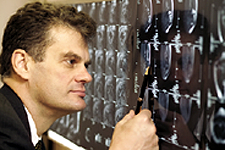
Papanicolaou Corps Gives $2.25 Million to Sylvester Cancer Center
Papanicolaou Corps Gives $2.25 Million to Sylvester Cancer Center
A Commitment to a Cure
![]() ontinuing
an unprecedented tradition of generosity, the Papanicolaou Corps for
Cancer Research announced a gift of $2.25 million to the UM/Sylvester
Comprehensive Cancer Center last May. The 14,000-member organization
has pledged to raise $10 million over five years. “We are very
pleased to present this donation,” says Gloria Berkowitz, president
of the Pap Corps, a volunteer group with members across three counties
that has supported cancer research at the University for 52 years. “Everyone
is affected by cancer in one way or another. Many of our members are
cancer survivors. Our members know the value of cancer research, and
we are all very proud to be able to contribute to this most important
cause.”
ontinuing
an unprecedented tradition of generosity, the Papanicolaou Corps for
Cancer Research announced a gift of $2.25 million to the UM/Sylvester
Comprehensive Cancer Center last May. The 14,000-member organization
has pledged to raise $10 million over five years. “We are very
pleased to present this donation,” says Gloria Berkowitz, president
of the Pap Corps, a volunteer group with members across three counties
that has supported cancer research at the University for 52 years. “Everyone
is affected by cancer in one way or another. Many of our members are
cancer survivors. Our members know the value of cancer research, and
we are all very proud to be able to contribute to this most important
cause.”
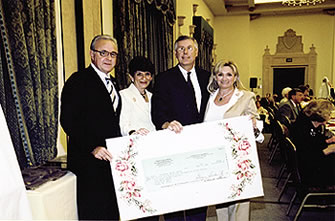 |
||
 |
||
The leadership of the Pap Corps presented a check to UM/Sylvester Director W. Jarrard Goodwin, M.D., F.A.C.S., and Board of Governors Chair Joaquin F. Blaya during a luncheon at the Boca Raton Resort and Club. “Looking back on the rich history of the Pap Corps there is no doubt that they have left an indelible mark on our community, one that will continue to have a positive impact for years to come,” Goodwin said.
UM/Sylvester Associate Director of Clinical and Translational Research Joseph D. Rosenblatt, M.D., and Miller School of Medicine Dean John G. Clarkson, M.D. ’68, were also on hand. “Research cures cancer, and no group works harder than the Pap Corps to support that effort,” says Rosenblatt. “The work we do at UM/ Sylvester would not be possible without their loyal support.”
The ongoing commitment of the Pap Corps funds critical research at UM/Sylvester, including work in tumor immunology, cancer cell biology, and genetics. The group has also helped fund investigations of melanoma and ovarian cancer, and new diagnostic tools for a variety of cancers at South Florida’s only university-based cancer center.
Recently the estate of Helen Herold provided a gift in excess of $1.5 million to be dedicated for vision research. Her legacy will enrich the research programs under way to find the causes and cures for glaucoma, age-related macular degeneration, and diabetic retinopathy. “We are extremely grateful to Helen Herold for this extraordinary act of generosity and philanthropy,” says Carmen A. Puliafito, M.D., M.B.A., chairman of Bascom Palmer. “Mrs. Herold’s remarkable gift will enable Bascom Palmer to act upon her dream of innovative vision research to benefit future generations.” Debra Durant, assistant vice president for public affairs and community relations at the Miller School of Medicine and former director of development at Bascom Palmer, fondly recalled Herold and her keen interest in medical research. “This amazing gift from her estate is a wonderful tribute to her conviction. Helen was a practical woman who had excellent business skills, and Bascom Palmer was one of her favorite organizations.” |
Cleary and Thoroughbred Industry Support Miami Project
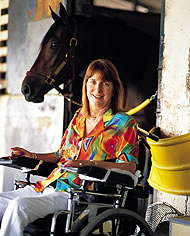 |
||
 |
||
A Transformational Opportunity
![]() wise
philosopher once observed, “The pessimist sees difficulty in every
opportunity while the optimist sees opportunity in every difficulty.” Robin
Cleary is a person who sees an opportunity to help find a cure for paralysis
and free thousands from the confinement and limitations of their wheelchairs.
Her goal is quite simple: “To tell my story to every person and
organization until we have raised enough money to free everyone from
their wheelchairs.”
wise
philosopher once observed, “The pessimist sees difficulty in every
opportunity while the optimist sees opportunity in every difficulty.” Robin
Cleary is a person who sees an opportunity to help find a cure for paralysis
and free thousands from the confinement and limitations of their wheelchairs.
Her goal is quite simple: “To tell my story to every person and
organization until we have raised enough money to free everyone from
their wheelchairs.”
Cleary, a trainer, was left paralyzed from an accident while galloping horses at Calder Race Course eight years ago. Despite the devastating injury that left her a quadriplegic, Cleary did not give up. “The accident provided me with a choice: either to let the injury dictate the way I might spend the remainder of my life, or do something about it,” she says. “I truly believe that what I’m doing is making a difference as researchers and physicians at The Miami Project to Cure Paralysis move closer to a cure.”
Cleary’s specific interest in The Miami Project rests in the organization’s total commitment to finding more effective treatments and ultimately a cure for paralysis. “When I learned that Dr. Dietrich (scientific director) was expanding The Miami Project’s regeneration research programs, I knew I needed to become actively involved,” she says. With the help and encouragement of her husband and fellow trainer Brian, she went from track to track, jockey to jockey, and trainer to trainer, sharing her life-altering experience and urging the horse industry to help others afflicted with spinal cord injuries.
Cleary has raised nearly $600,000 over the past eight years from the thoroughbred industry. Although many of her friends and associates refer to her as a hero, Cleary is quick to dismiss the notion. “I don’t consider myself a hero. I am just trying to do the best with the resources I can draw from,” she says. “If I didn’t have the support of the horse business and the horse racing community, I would never have been able to raise this amount of money.”
In the past year Cleary has been able to use a robotic walking system, which simulates the walking motion. “That was the most exhilarating feeling I had since my injury eight years ago,” she says.
Although Cleary has a conference room named after her in the Lois Pope LIFE Center, she really only has one wish: to get out of her wheelchair and walk again. “I hope I don’t have to raise another half million dollars before that day finally arrives,” she says.
Culverhouse Family Gift Supports Research
The gift will help Temple continue his work in musculoskeletal oncology research, specifically the study of tumor responses to chemotherapy. Temple’s research compares pre- and post- treatment MR [magnetic resonance] images with pathologic specimens. The results play an important role in helping oncologists better predict which tumors might respond to treatment. The use of chemotherapy in patients with non-metastatic soft tissue sarcomas has had some promising results. The Sarcoma Group at the University of Miami has been in the forefront of chemotherapeutic intervention for patients with non-metastatic bone or soft tissue sarcomas. |
The Kennedy Family Foundation
A Tradition of Helping
“Unless we
give part of ourselves away, unless we can live with other people and
understand them and help them, we are
missing the most essential part of our own human lives.”
— Harold
Taylor, former president, Sarah Lawrence College
![]() his
philosophy has been the guiding light and principal motivation of The
Ethel and W. George Kennedy Family Foundation, a private Coral Gables-based
family foundation created in 1968.
his
philosophy has been the guiding light and principal motivation of The
Ethel and W. George Kennedy Family Foundation, a private Coral Gables-based
family foundation created in 1968.
Following the death of his wife, Ethel, W. George Kennedy established the foundation in her memory. During the course of their lifetimes, the Kennedys were committed to improving the quality of life in Miami-Dade County. Today the foundation continues the tradition of giving for a variety of purposes and projects, mainly focusing on children.
![]() Although George Kennedy died
in 1986, the foundation’s work is carried
on by four of the couple’s six adopted children. “They set a standard
for us,” explains Kathleen Kennedy-Olsen, the foundation’s managing
director. Sister Kimberly Kennedy adds, “Considering where our father
came from, growing up poor and becoming a self-made man, he lived in those
situations
and understood what it was like to experience poverty. I think he never forgot
those early roots and wanted to help others.”
Although George Kennedy died
in 1986, the foundation’s work is carried
on by four of the couple’s six adopted children. “They set a standard
for us,” explains Kathleen Kennedy-Olsen, the foundation’s managing
director. Sister Kimberly Kennedy adds, “Considering where our father
came from, growing up poor and becoming a self-made man, he lived in those
situations
and understood what it was like to experience poverty. I think he never forgot
those early roots and wanted to help others.”
Born in Canada, George Kennedy came to Miami in the early 1920s and made his fortune in land development, insurance, and banking. He met his future wife, Ethel, when she answered an ad for a position at his insurance agency.
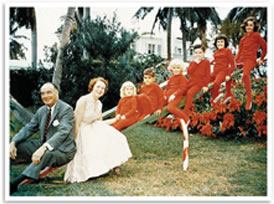 |
||
The importance of philanthropy was instilled in all six children of different nationalities whom the Kennedys adopted as babies. Kennedy-Olsen says her parents, who were in their 50s, would have adopted more, but her mother’s illness prevented that. “Ever since we were small, the spirit and concept of giving to others was an important part of our lives. I remember as a child going to this one house and delivering a box of canned goods and a turkey to a family. It was a wonderful feeling to see the excitement and happiness of the parents and kids in this tiny house,” she recalls.
Today the foundation is operated by four of the children, Kathleen Kennedy-Olsen, Kimberly Kennedy, Karyn Kennedy Herterich, and Kendel Kennedy. It’s among the 20 largest charitable foundations in Miami-Dade County, with nearly $26 million in assets and annual grants totaling $1.5 million.
The foundation’s relationship with the Miller School of Medicine goes back decades. Ethel Kennedy helped organize the Papanicolaou Corps for Cancer Research. Over the years the foundation has supported UM’s Center for Research in Medical Education, Department of Pediatrics, including the Pediatric Mobile Clinic and pediatric cardiology programs, Bascom Palmer Eye Institute, and the Center for Family Studies. All told, the foundation has funded nearly $2.5 million in University-affiliated programs.
Michael Gordon, M.D., associate dean and director, Center for Research in Medical Education, was George Kennedy’s physician 25 years ago. “George Kennedy was a gent. I remember telling him of our needs for cardiology training at the University of Miami. The next day a large donation was received,” Gordon affectionately recalls.
“Since George passed away, his children, the trustees of his foundation, have been equally generous. They constructed the George and Ethel Kennedy Emergency Medical Skills Training Center, where we train thousands of vitally needed emergency personnel each year,” Gordon adds. “The Kennedy family members are our partners and our friends.”
The Kennedy daughters note that their parents left them with a legacy to do good in the world. “Our parents were from a generation and time of elegance, style, and class,” Kennedy-Olsen says. “They believed in doing the right thing for the right reason.”
Innovative Therapy studied to treat Macular Degeneration
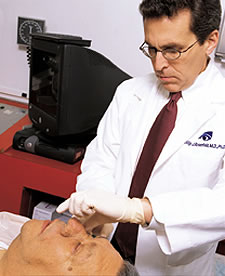 |
||
A Vision to Restore Eyesight
![]()
![]() eter
Mosheim first became acquainted with Bascom Palmer Eye Institute through
his neighbor and longtime friend Richard K. Forster, M.D., professor
of ophthalmology and a cornea specialist at Bascom Palmer. Little did
Mosheim realize that he would need the services of Bascom Palmer’s
retina department in the years to come.
eter
Mosheim first became acquainted with Bascom Palmer Eye Institute through
his neighbor and longtime friend Richard K. Forster, M.D., professor
of ophthalmology and a cornea specialist at Bascom Palmer. Little did
Mosheim realize that he would need the services of Bascom Palmer’s
retina department in the years to come.
Diagnosed with age-related macular degeneration in 1996, he has been supporting the research of Philip J. Rosenfeld, M.D., Ph.D., associate professor of ophthalmology, who recently launched a new study utilizing photodynamic therapy. The therapy combines the use of a photosynthesizing drug with a laser to destroy abnormal blood vessels under the retina.
“I enjoy supporting research and medicine. Dr. Rosenfeld’s work holds great promise and may someday benefit my condition,” Mosheim says.
The study, which began in April 2004, is being conducted by Rosenfeld and Carmen A. Puliafito, M.D., M.B.A., chairman of Bascom Palmer, and is looking at those with wet age-related macular degeneration. (Wet macular degeneration is caused by abnormal blood vessels growing from under the retina in the macula. The blood vessels leak blood and fluid that lift the macula from its normal place at the back of the eye.) “I am delighted that Mr. Mosheim and his wife, Marion, are supporting this research,” Rosenfeld says. “I am convinced that this new study will help us understand why patients develop wet age-related macular degeneration and will result in a new treatment for this blinding disease.”
PERSONAL BACKGRUND: L. Jules Arkin has lived in Miami since 1935. From his earliest days, he has been involved in the community and active in numerous civic and philanthropic activities, including the Greater Miami Jewish Federation, the Miami Beach Chamber of Commerce, and Kiwanis. He practiced law until about 20 years ago, when health problems promptedhim to give up the practice. GIFT: Arkin and his wife, Shirley, recently established two endowments providing stipends for fellowships in retina and cornea care at the University of Miami’s Bascom Palmer Eye Institute. GIVING PHILOSOPHY: I grew up in a charitable family environment. My parents set the example at an early age, and I have continued this tradition. I served as campaign chair of the Greater Miami Jewish Federation and raised $20 million one year. I decided to create a family foundation so that my children and grandchildren could have a vehicle to continue to carry on the concept of giving. I guess Albert Einstein expressed it best when he said, “It is every man’s obligation to put back into the world at least the equivalent of what he has taken out.” WHAT BASCOM PALMER EYE INSTITUTE MEANS TO ME: My wife and I have been patients at Bascom Palmer for the past 30 years. We feel very deeply about the excellent care we receive from the doctors and staff. Shirley and I wanted to help fellows who need support so that the fellowship program can continue to prosper and train more doctors to meet the needs of patients. Establishing a fellowship program is the least we could do to repay the University for the excellent medical care it has provided to us. |
| Photography by Johm Zillioux/Illustration by Jim Frazier |
|
|
|
|
|
|
|
|
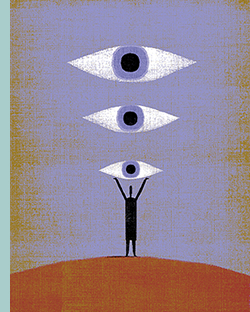 A Legacy of Vision
A Legacy of Vision
